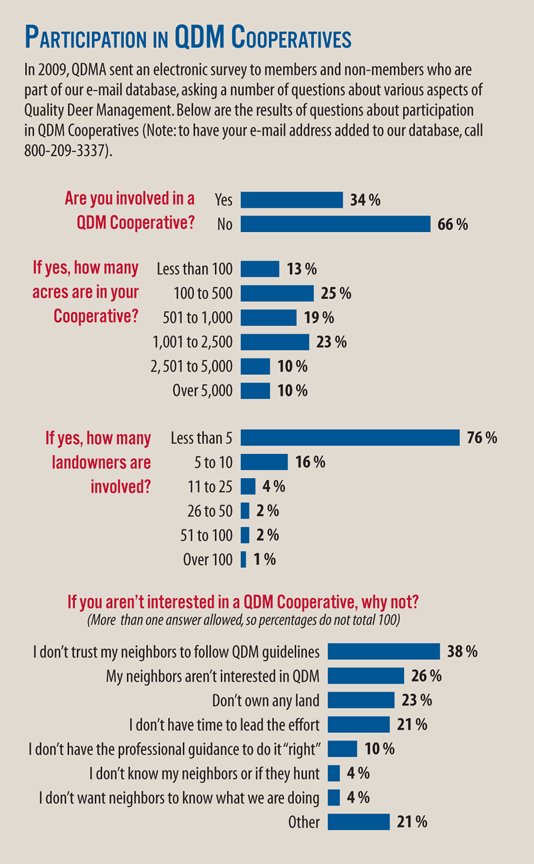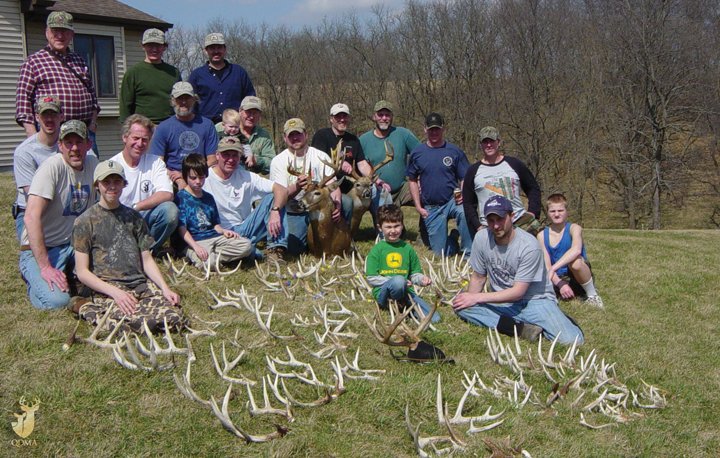Quality deer management (QDM) is about balancing the deer herd with the habitat, balancing the adult sex ratio, and balancing the age structure for bucks and does. Sometimes, this is easier said than done, especially when most deer managers own or manage acreages far smaller than deer home ranges. This is where QDM Cooperatives come into play. A QDM Cooperative is a group of landowners and hunters working together to improve the quality of the deer herd, habitat and hunting experiences on their collective acreage. QDM Cooperatives are rapidly spreading across the whitetail’s range, and a recent survey of QDMA members showed an astounding 34 percent of respondents were involved in a QDM Cooperative. That equates to tens of thousands of hunters and millions of acres, resulting in an enormous impact on deer herds and wildlife habitats across the whitetail’s range (See the graphic below for more statistics that emerged from our survey about Cooperatives).
Let’s face it, most hunters don’t own enough land to completely contain a single deer’s movement patterns, let alone multiple deer or an entire population. Fortunately, Cooperatives allow landowners to pool their lands to have a much larger impact on deer herds and management programs. Cooperatives offer numerous benefits to landowners including reduced management costs, reduced trespassing, the ability to share data for a better “picture” of the local deer herd, and most importantly, increased acreage to manage.
The size of a Cooperative can vary based on the number of people involved. Some may be as small as a few hundred acres with a handful of landowners, while others may be thousands of acres with hundreds of participants. Bigger is typically better, but any increase in acreage generally improves the success of your QDM efforts. The QDM Cooperative shown in the photo above is in Wisconsin, and it started from a single 190-acre property; it now exceeds 4,000 acres and includes dozens of properties.
Cooperatives are always voluntary and in no way entitle hunters access to other properties or diminish the landowner’s control. They simply pool acreage to be managed under common objectives and goals. Participation requirements vary with each Cooperative. At a minimum, most require members to make a legitimate effort to protect yearling bucks and harvest an appropriate number of does. In all cases the rules are determined and voted on by the members of the Cooperative.
Now that you know what a QDM co-op is and understand the benefits of belonging to one, here’s how to get one established.

The next step is to select a central meeting location, date and time. In most cases a community center, social club lodge, restaurant, hunting camp, or similar location is most appropriate. Determine the meeting date and time based on availability and proximity of attendees. If possible, provide a complimentary meal as it will increase attendance and demonstrate your level of commitment. An informal barbecue is a great way to get folks to attend and enjoy themselves.
It is a good idea to obtain the assistance of a local wildlife biologist. He/she can answer biological questions relating to the benefits of a Cooperative and provide information on the local deer herd. There are several sources for wildlife biologists including state wildlife agencies, timber companies, private consultants, universities, and QDMA. If possible I strongly encourage you to include a representative from another successful Cooperative. They can help alleviate concerns and provide support for the Cooperative.
Some landowners may not be interested initially. That is fine – do not pressure them. Respect their right to dictate the type of management they desire on their properties. Often they will join at at a later date as they become convinced of the merits by other participants.
The first meeting should be to explore the possibility of forming a Cooperative, not to actually form one. This is an important distinction. An appointed spokesperson should outline how the Cooperative could work and could include key points like protecting yearling bucks, shooting the right number of antlerless deer, collecting harvest data, etc.
You should maintain communication with all interested participants and host the second meeting within two months. This is when you establish the Cooperative. Some landowners and hunting groups will have already committed to establishing a Cooperative. This helps create a friendly atmosphere for others to join. The follow-up meeting should begin with a quick recap of the first meeting, and then begin securing commitments to the Cooperative and establishing basic membership guidelines.
Membership in the QDM Cooperative can be formal or informal. In general, the more properties and people involved, the greater the need for a formalized membership process. It is a good idea to establish some acknowledgement of Cooperative members such as property signs, vehicle decals, and/or membership cards (You can purchase “QDM Cooperative” boundary signs from QDMA’s online store). In most cases, no fee is attached to membership in the Cooperative. Possible exceptions may include costs associated with mailings to Cooperative members, signs, decals, awards, or food for an annual meeting.
Hopefully as the Cooperative becomes successful, additional landowners and hunt clubs will want to join. This is great, and it’s exactly what you’re looking for. The success of a QDM Cooperative is dictated by the quality and efforts of participants. New members can bring excitement and new ideas.
Unfortunately every Cooperative has to deal with uncooperative neighbors at some point. Often, activities on non-member properties within or adjacent to Cooperative boundaries will create problems. These activities may range from no hunting at all to the harvest of young bucks. Regardless, never give up hope and keep these landowners and non-member groups informed of the activities and successes with the Cooperative. Nothing will do more to encourage their participation in the future than to make it clear that they are missing out on the benefits of membership. It also is a good idea to encourage these landowners and hunters to attend QDM seminars or to join QDMA. Once they gain a better understanding of QDM, they will be more likely to join the Cooperative in the future. If all else fails, recognize that some losses to neighboring properties will occur and manage accordingly.
Once the Cooperative is formed, realistic deer management goals and strategies must be established. The goals should be specific and measurable. For example, goals could include increasing the average body weight and/or antler measurements for a given buck age class, improving the adult sex ratio, and reducing the percentage of button bucks in the harvest. The time required to achieve these goals depends on the management strategies selected, habitat quality, and commitment level of participants. Changes will not occur overnight, and participants should commit for a minimum of three to five years.
Once a Cooperative is established, the challenge is to maintain it and promote participation by neighbors. The key is to ensure that involvement is enjoyable. Also, keep members informed. I recommend Cooperatives meet at least annually to review progress and fine-tune their goals. Many Cooperatives meet prior to and following the hunting season. The pre-season meeting should involve a review of the previous year’s data to establish objectives for the upcoming season. The post-season meeting provides an opportunity to review how well members adhered to the guidelines and any problems that arose. It is also a great time for members to bring the mounted heads, antlers, or photos of any harvested bucks for members to view. Under the QDM Cooperative approach, when a mature buck is harvested, pride is shared by all members as one or more may have passed the buck at an earlier age.
Communication is critical to the success of a Cooperative. Typical ways of keeping members informed include distribution of annual harvest reports and periodic newsletters. These can be simple or elaborate depending on the needs of the Cooperative and the time and abilities of the person(s) coordinating such efforts. Finally, be patient, expect mistakes and obstacles, and always work as a team.
If you’re a small-acreage landowner, a QDM Cooperative can be a great benefit to you. The best way to ensure the young bucks in your area are protected is to get as many of your neighbors as possible involved in the Cooperative. Given the distances some bucks move, it’s to your benefit to talk to your immediate neighbors, the landowners who border your neighbors, and even the landowners two or more properties removed from yours. It is true that not all of them will be interested in QDM, but many will. Begin communicating with those who are interested, and chances are your success will grow over time. This doesn’t mean you can’t have a high-quality QDM program without a Cooperative, but in most cases you can be far more successful by being involved in one.
For more information on QDM Cooperatives see QDMA’s Developing Successful Cooperatives booklet.
